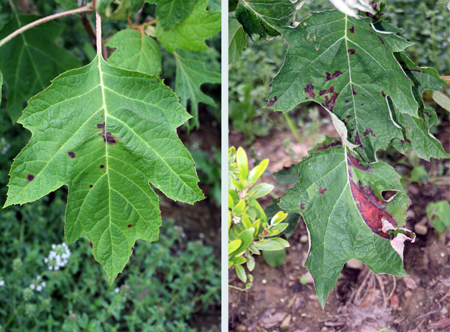Bacterial leaf spot on hydrangea
Editor’s note: This article is from the archives of the MSU Crop Advisory Team Alerts. Check the label of any pesticide referenced to ensure your use is included.
Recent weather conditions have been conducive for the development of bacterial leaf spot on hydrangea. This disease is caused by the bacterial pathogen Xanthomonas campestris. Disease is favored by warm, wet conditions in late spring and early summer. Three types of hydrangea are most commonly affected, H. quercifolia (oakleaf hydrangea), H. macrophylla, and H. arboreacens. In my experience, disease is particularly severe on oakleaf hydrangea.
Disease symptoms typically begin on lower leaves and work their way upward as the season progresses. Leaf spots are dark reddish-purple and may have angular edges, where they are bordered by leaf veins (Photo 1). The individual spots are larger on oakleaf hydrangea than on other types of hydrangea. Over time, the lesions enlarge, coalesce and encompass large patches on the infected leaves. Unfortunately, this symptom is currently present on my own oakleaf hydrangeas (Photo 2).
Moist conditions promote a rapid increase in the amount of bacteria present; this allows for further disease spread. Splashing rain and irrigation water spread the pathogen to nearby foliage. The pathogen subsequently enters the plant tissue through natural openings (stomates and hydathodes) or through wounds in the leaf surface. Bacterial leaf spot symptoms appear on hydrangea foliage within three to seven days after infection.
Ideally, in the early stages of disease development, leaves with leaf spot symptoms should be removed from the plants. This may only be practical on plants that are in residential landscapes. By removing the infected leaves, the amount of the pathogen present is reduced. Wetting of hydrangea foliage from overhead irrigation and overspray from lawn irrigation systems should be avoided, or at least timed to minimize the duration of leaf wetness. In nursery settings, good plant spacing, which allows for air movement and more rapid drying of foliage, is recommended. Applications of copper-based fungicides in late spring can be used to help limit disease spread. Fungicides should only be a part of an overall disease management program; applications are not likely to be effective in conditions that are otherwise favorable for disease.

Photos 1 and 2. Left, angular lesions bordered by veins. Right,
coalesing lesions.
Reference Used: Jones and Benson, 2001. Diseases of Woody Ornamentals and Trees in Nurseries, APS Press.



 Print
Print Email
Email


